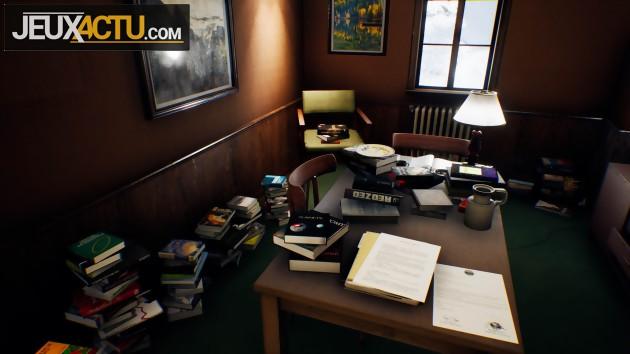 This adventure invites us to embody Nicole who, when her father has just died, returns to the family hotel in order to close the sale and leave painful memories far behind her. It must be said that the head of the family cheated on his wife with Rachel Foster, a sixteen-year-old girl who ended up committing suicide. The tone is set: intimate and dark. It is December 1993, ten years after this tragedy, and extreme weather conditions prevent Nicole from settling legal matters as quickly as she would like. Blocked by the snow, she is forced to spend a few days alone in the hotel. Naturally, this forced stay will force him to learn more about the heavy family past. To keep her company, she can count on Irving, an employee of the emergency services with whom she speaks regularly on the telephone. This allows us to immediately address the main strong point of the game: the soundtrack. The American actors ring true, the melancholic music sticks perfectly to the subject, and the sound effects are glaringly true, especially if you play with headphones since the game has benefited from a binaural recording. From this point of view, nothing to complain about!
This adventure invites us to embody Nicole who, when her father has just died, returns to the family hotel in order to close the sale and leave painful memories far behind her. It must be said that the head of the family cheated on his wife with Rachel Foster, a sixteen-year-old girl who ended up committing suicide. The tone is set: intimate and dark. It is December 1993, ten years after this tragedy, and extreme weather conditions prevent Nicole from settling legal matters as quickly as she would like. Blocked by the snow, she is forced to spend a few days alone in the hotel. Naturally, this forced stay will force him to learn more about the heavy family past. To keep her company, she can count on Irving, an employee of the emergency services with whom she speaks regularly on the telephone. This allows us to immediately address the main strong point of the game: the soundtrack. The American actors ring true, the melancholic music sticks perfectly to the subject, and the sound effects are glaringly true, especially if you play with headphones since the game has benefited from a binaural recording. From this point of view, nothing to complain about!With a title that strongly evokes The Vanishing of Ethan Carter or What Remains of Edith Finch, a narration that borrows a lot from Firewatch, and a setting that inevitably recalls that of Gone Home, we cannot say that the developers of The Suicide of Rachel Foster seeks to conceal their influences.
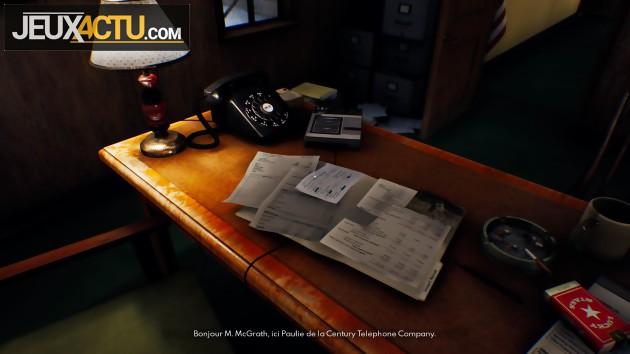 Similarly, we can salute the quality of the sets, which are teeming with details and establish a realistic atmosphere supported by completely correct graphics. We will particularly appreciate the presence of many emblematic objects from the 80s, whether VHS tapes, a Polaroid camera, a magic dictation, a lava lamp and even one or two terminals arcade (not playable, alas). But back to the incessant phone conversations between Nicole and Irving. If the latter are naturally used to advance the scenario, they are very reminiscent of exchanges via Firewatch walkie-talkie. As for the hotel and its few secret passages, they are reminiscent of the family home of Gone Home. Finally, the theme of the family drama is not very far from that of What Remains of Edith Finch. If these references are rather prestigious and have marked the history of narrative games, The Suicide of Rachel Foster unfortunately struggles to rise to their level.
Similarly, we can salute the quality of the sets, which are teeming with details and establish a realistic atmosphere supported by completely correct graphics. We will particularly appreciate the presence of many emblematic objects from the 80s, whether VHS tapes, a Polaroid camera, a magic dictation, a lava lamp and even one or two terminals arcade (not playable, alas). But back to the incessant phone conversations between Nicole and Irving. If the latter are naturally used to advance the scenario, they are very reminiscent of exchanges via Firewatch walkie-talkie. As for the hotel and its few secret passages, they are reminiscent of the family home of Gone Home. Finally, the theme of the family drama is not very far from that of What Remains of Edith Finch. If these references are rather prestigious and have marked the history of narrative games, The Suicide of Rachel Foster unfortunately struggles to rise to their level.EDITH 1 – RACHEL 0
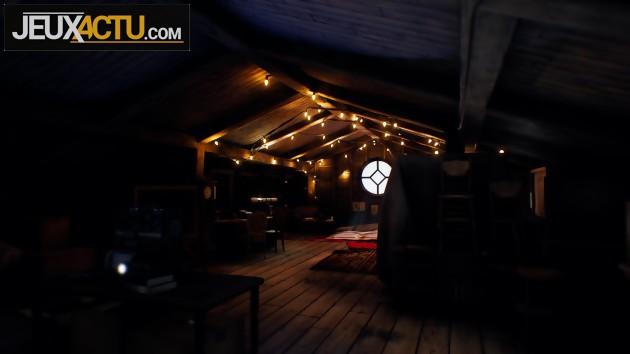 First off, don't count on One-O-One Games production to introduce a bit more gameplay to the genre. There is no real inventory, the zoom key is absolutely useless throughout the adventure, and the possibility of observing certain objects from all angles is never used to solve a puzzle. or introducing a little extra interaction. You will spend most of your time moving around the four floors of the hotel (basement, ground floor, first and second floor), trying to find your way on the map, listening to Irving, occasionally choose from two possible answers (with no real consequences) and that's about it. The game, however, offers us three interactive tools: a dynamo flashlight, a Polaroid, and a parabolic microphone. The first only illuminates for a few moments and is rarely useful, the second does not allow you to take pictures but just trigger the flash (it is therefore totally redundant with the flashlight), and the third does not is used only during a single sequence.
First off, don't count on One-O-One Games production to introduce a bit more gameplay to the genre. There is no real inventory, the zoom key is absolutely useless throughout the adventure, and the possibility of observing certain objects from all angles is never used to solve a puzzle. or introducing a little extra interaction. You will spend most of your time moving around the four floors of the hotel (basement, ground floor, first and second floor), trying to find your way on the map, listening to Irving, occasionally choose from two possible answers (with no real consequences) and that's about it. The game, however, offers us three interactive tools: a dynamo flashlight, a Polaroid, and a parabolic microphone. The first only illuminates for a few moments and is rarely useful, the second does not allow you to take pictures but just trigger the flash (it is therefore totally redundant with the flashlight), and the third does not is used only during a single sequence.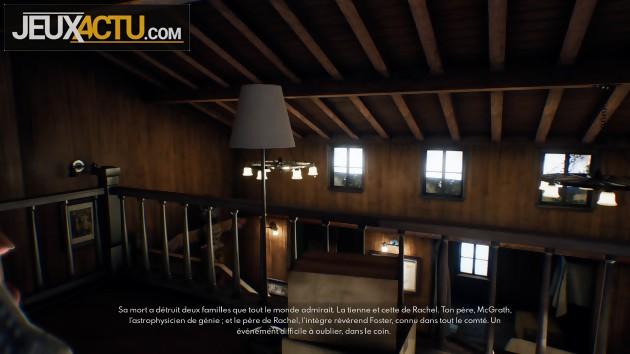 Another grievance concerns the speed, or rather the slowness, of the movements. It's very simple, we have to constantly press the race control for the experience to be bearable. The developers would have done better to stall the speed of walking on that of running and slightly increase the latter. But maybe they wanted to artificially extend the lifespan? This could explain this sequence where we have to heat food in the microwave … and where the game forces us to wait stupidly to do nothing for a minute. The unnecessary length of certain dialogues also seems to betray a fear of the studio regarding the lifespan (which, by the way, is in the low average of the genre and does not exceed three hours). Even Nicole breaks out at one point with a "Damn! How talkative you can be sometimes!" contrary to Irving... Without being bad, the writing is never great. It does the job but nothing more, which is quite disappointing for a narrative game.
Another grievance concerns the speed, or rather the slowness, of the movements. It's very simple, we have to constantly press the race control for the experience to be bearable. The developers would have done better to stall the speed of walking on that of running and slightly increase the latter. But maybe they wanted to artificially extend the lifespan? This could explain this sequence where we have to heat food in the microwave … and where the game forces us to wait stupidly to do nothing for a minute. The unnecessary length of certain dialogues also seems to betray a fear of the studio regarding the lifespan (which, by the way, is in the low average of the genre and does not exceed three hours). Even Nicole breaks out at one point with a "Damn! How talkative you can be sometimes!" contrary to Irving... Without being bad, the writing is never great. It does the job but nothing more, which is quite disappointing for a narrative game.Most annoying is the overall clumsiness of the adventure in terms of how to guide the player. Sometimes she leaves him too much freedom (like at the beginning of the game where you can easily find yourself visiting the whole hotel without a real objective), and sometimes she imposes limits on him that break the immersion.
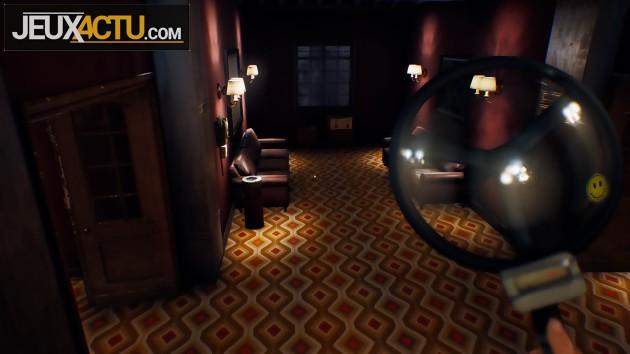 Most annoying is the overall clumsiness of the adventure in terms of how to guide the player. Sometimes she leaves him too much freedom (like at the beginning of the game where you can easily find yourself visiting the whole hotel without a real objective), and sometimes she imposes limits on him that break the immersion. One thinks for example of the impossibility of picking up the flashlight and the Polaroid before these elements are introduced into the scenario. However, picking up the first seems obvious in a game where you have to explore a quasi-mansion. As for the second, if you ever go for a quick look in the options before launching the game, you will know straight away that it is a gameplay element, but you will not be able to take possession of it when you want. however. Poorly done scripts also introduce some dissonance between the player and Nicole's character. For example, the latter will express her surprise by "discovering" a sleeping bag towards the end of the adventure... whereas as a player you will have already noticed this element, and more than once. Along the same lines, one of the endless dialogues gives us clues about a particular room in the hotel. But when Nicole realizes which room it is, the somewhat quick-witted player has already been in front of the right door for several minutes waiting for the telephone conversation to end.
Most annoying is the overall clumsiness of the adventure in terms of how to guide the player. Sometimes she leaves him too much freedom (like at the beginning of the game where you can easily find yourself visiting the whole hotel without a real objective), and sometimes she imposes limits on him that break the immersion. One thinks for example of the impossibility of picking up the flashlight and the Polaroid before these elements are introduced into the scenario. However, picking up the first seems obvious in a game where you have to explore a quasi-mansion. As for the second, if you ever go for a quick look in the options before launching the game, you will know straight away that it is a gameplay element, but you will not be able to take possession of it when you want. however. Poorly done scripts also introduce some dissonance between the player and Nicole's character. For example, the latter will express her surprise by "discovering" a sleeping bag towards the end of the adventure... whereas as a player you will have already noticed this element, and more than once. Along the same lines, one of the endless dialogues gives us clues about a particular room in the hotel. But when Nicole realizes which room it is, the somewhat quick-witted player has already been in front of the right door for several minutes waiting for the telephone conversation to end.GAME SUICIDE?
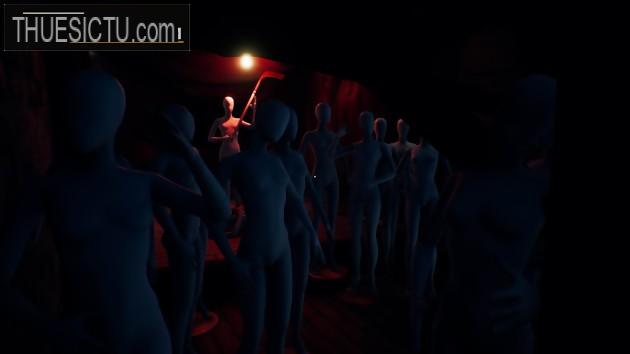 Some more specific defects are also to be noted, such as this bug which cuts the sound of the game at times, or even the French translation which has some failures. We think in particular of this objective which indicates the ground floor as our destination when it is actually the first floor (and so much the worse for the twenty minutes of life lost going around in circles…) or even the phrase "I must inspect the 'Attic'", which seems to indicate that the translator took the word "attic" for a proper noun. The inability to disable controller vibration or remap keyboard keys are also slightly unfortunate. Finally, the conclusion of the adventure seems to be able to lead to two different endings, but the game does not leave us the possibility of reloading a save point in order to be able to make a second choice. In the end, The Suicide of Rachel Foster therefore appears to be an average narrative game, which will have a hard time convincing fans of the genre or even seducing novices.
Some more specific defects are also to be noted, such as this bug which cuts the sound of the game at times, or even the French translation which has some failures. We think in particular of this objective which indicates the ground floor as our destination when it is actually the first floor (and so much the worse for the twenty minutes of life lost going around in circles…) or even the phrase "I must inspect the 'Attic'", which seems to indicate that the translator took the word "attic" for a proper noun. The inability to disable controller vibration or remap keyboard keys are also slightly unfortunate. Finally, the conclusion of the adventure seems to be able to lead to two different endings, but the game does not leave us the possibility of reloading a save point in order to be able to make a second choice. In the end, The Suicide of Rachel Foster therefore appears to be an average narrative game, which will have a hard time convincing fans of the genre or even seducing novices.


























